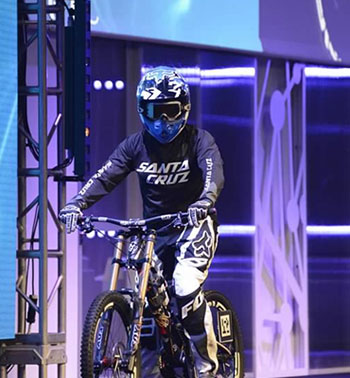
Image courtesy of PTC.
Previously, manufacturers relied on customer feedback to maintain and upgrade products; now, product analytics can fix issues before they happen — and create new opportunities for product design and service. This is done by listening to the “voice of the product or data,” where manufacturers can gather, interpret, and feed product data back into the design cycle, enabling a new set of capabilities that builds value for manufacturers and customers, all driven by the IoT.
Imagine listening to the “voice” of a Santa Cruz mountain bike. The bike, pictured above at the opening of the Boston-based IoT event LiveWorx, demonstrates how physical products can be dissected to their digital cores and this knowledge used to predict and resolve problems. The bike, fitted with sensors and a Raspberry Pi computer for connectivity, tracked wheel speed, suspension pressure, and angle of the steering wheel — all of which was connected to the cloud using our ThingWorx IoT platform. As it was ridden around the stage, its motions were displayed inside a computer-aided design (CAD) model. Combining the power of CAD and product lifecycle management (PLM) with our IoT platform, we merged the bike’s real-world physical interactions into the digital world, creating a “digital twin,” an exact digital representation of the physical bike.
Combining the digital twin with augmented reality, using the know-how of 3D CAD and PLM, we have the ability to measure and monitor performance of that mountain bike in real time. The IoT is powering the digital twin, moving from collecting data to acting on that data. The manufacturing industry is building toward this future by blurring the lines between products and services. Understanding the “voice” allows companies to act on the data created by connected systems in everything from smart cars and enterprise IT apps to consumer products — companies are creating new market opportunities that are changing how consumers and products interact with each other. Check out the demo to see the bike in action.
“[A bike] is a good model for how you can do this for many, many products,” Jim Heppelmann, PTC CEO, explains. “Imagine the power of this concept if you were to project it onto a piece of heavy equipment or onto an aircraft.” It can help enhance in-person jobs, such as inspection, maintenance, and service of shop-floor machinery and field service events. You can understand the problem before you begin work on the product, ensuring the most efficient use of time on-site or on the floor.
“The thing has a voice and it wants to be heard. The Internet of Things already has begun to let things speak,” says Heppelmann. “The next step is to act on what they’re saying. There’s really a tremendous amount of information available to us now, and there’s huge value in understanding the usage data of that thing.”
Learn more about PTC’s ThingWorx application enablement platform at the O’Reilly Solid Conference. We will be speaking at the event and available in the Solid Showcase at Booth 233, where you can glimpse the “digital twin” and see IoT technology in action.
This post is a collaboration between O’Reilly and ThingWorx. See our statement of editorial independence.
